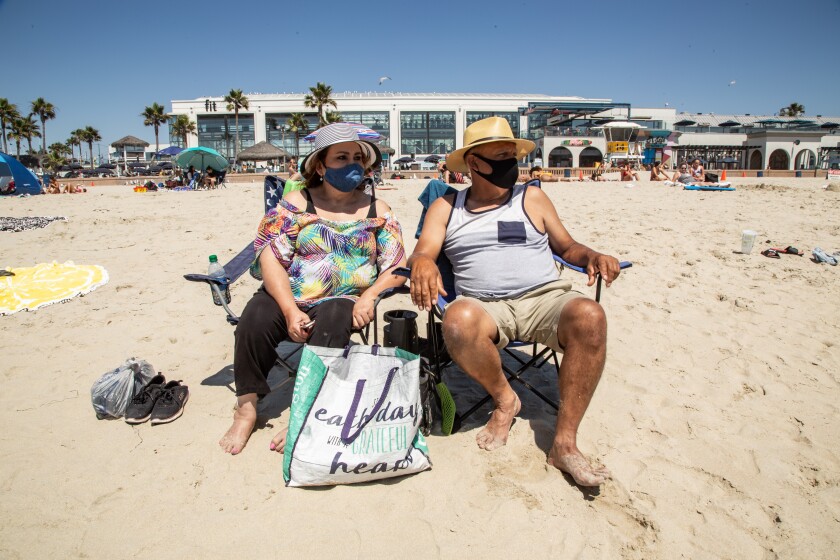
Of the many coronavirus metrics rising in California, one of the most troubling is the rate in which coronavirus test results are now coming back positive.
A Times data analysis found that as of Friday, 5.7% of coronavirus test results in California over the preceding seven days came back positive, a rate not seen since early May. A week ago, the rate was 4.7%, a rate that had been largely stable for June until just Sunday, when there was a dramatic shift in the numbers.
Health officials say the rising percentage of coronavirus test results confirming infection indicated that the virus is beginning to spread in communities as more counties in California ease stay-at-home orders, allowing many businesses to reopen.
The state has seen a surge in COVID-19 cases and hospitalizations in recent weeks that officials attribute to a variety of factors including people increasingly leaving home; holding social gatherings; failing to wear face coverings; outbreaks in nursing homes, prisons, newly opened workplaces and overcrowded homes; and recent political protests.
The so-called “positivity rate” has become an increasingly close-watched indicator of how much the coronavirus is spreading, and its steady rise over the last week is causing concern.
“The numbers do tell us that we’re seeing an increase in community transmission,” Barbara Ferrer, the director of public health for L.A. County, said this week.
On Sunday, the rate of coronavirus tests confirming infection over the previous seven days in California was up to 4.8%. The next day, it was 4.9%. By Tuesday, it was 5.3%, and on Friday, it was 5.7%.
Rural Imperial County, one of the nation’s most important agricultural areas east of San Diego, now has the highest test positivity rate of any county in the state, with a seven-day average of 23% — well over the 8% rate that causes particular concern among state officials. Outbreaks there have overwhelmed local hospitals, forcing more than 500 patients to be sent to other counties for care.
The situation in Imperial County is so bad that Newsom said Friday the state was recommending that county officials reimpose a strict stay-at-home order — the first time officials have taken such a drastic move. With 5,744 cases and 73 deaths, Imperial County has the highest rate of coronavirus cases per capita in California, according to The Times’ pandemic tracker.
“We are advising and counseling them to move forward and reinstitute a stay-at-home order, but they will move at their discretion,” Newsom said. “If they are not able to come to some consensus, I am committed to intervening as is my role and responsibility as governor in the state of California.”
Imperial is among an increasing number of California counties the state is monitoring because they have exceeded criteria set by the state to address the pandemic, including thresholds for hospitalizations and positive COVID-19 tests.
Initially, the list was focused on Southern California and the San Joaquin Valley, but now has spread to the Bay Area. Including Imperial, the 15 counties are Contra Costa, Fresno, Kern, Kings, Los Angeles, Riverside, Sacramento, San Bernardino, San Joaquin, Santa Barbara, Santa Clara, Stanislaus, Tulare and Ventura.
Newsom urged people in denial about the worsening pandemic to realize the new reality.
“Let us disabuse ourselves that somehow — the lazy punditry that was out there — that somehow this is a seasonal disease and triple-digit weather will annihilate it. Look at these states that are seeing unprecedented record increases,” Newsom said.
Conditions were also deteriorating Friday in San Bernardino County. Officials there said local hospitals are beginning to reach “surge capacity” because of new coronavirus cases, meaning they are getting close to hitting their licensed limits for the number of available beds.
They stressed that there is still room for more patients but said the system is becoming stressed. The county said it would consider opening alternate care sites for patients if hospitals fill up.
California has seen a 36% increase in hospitalizations of patients with confirmed COVID-19 disease, and a 24% jump in ICU patients with verified infections, over the past 14 days.
Los Angeles County is also recording an increasing rate of test results coming back positive for the coronavirus. On Friday, 8.8% of coronavirus test results were confirming infections as a daily average over the past week. Two weeks ago, on June 12, it was 5.8%.
While the rate of positive test results can help show the influence of more robust testing on rising case counts, there are still some pitfalls.
At the beginning of the pandemic, tests were limited and often only available to critically ill patients. Now in many parts of California, people without symptoms may be able to get swabbed for the virus. That would drive the positive rate down.
“At the end of the day, it’s really not telling us for sure what’s happening in the community,” said Ron Brookmeyer, a biostatistician and dean at the UCLA Fielding School of Public Health. “A falling positivity rate could be reflecting just that there’s a skew now, a shifting of who’s coming in for testing.”
Nonetheless, Brookmeyer said the recent increase in California’s positivity rate is a “troubling early warning sign,” adding that rising hospitalizations and deaths could follow.
“I would next be keeping a very careful eye on numbers of new hospitalizations,” he said.
In L.A. County, there were 1,302 hospitalized with confirmed coronavirus infections on June 1. As of Thursday, there were 1,660 — a 27% increase.
The worsening pandemic has caused Newsom to put a pause on issuing rules that would allow counties to reopen other industries, such as amusement parks. As a result, Disney said this week that Disneyland will not be able to open as previously planned on July 17.
There’s nothing to suggest California will be able to allow counties to open more industries any time soon, based on the rising cases and hospitalizations, Newsom said.
Newsom warned that the number of new daily deaths will likely go up in a few weeks. It can take three to four weeks after exposure to the virus for infected people to be hospitalized, and four to five weeks after exposure for patients to die from the disease.
Rising levels of disease caused several counties in the San Francisco Bay Area to signal a slowdown in the reopening process.
San Francisco is experiencing a surge in rates of COVID-19 infection and will have to pause its reopening, the city’s health director said Friday.
Businesses that were scheduled to reopen Monday will now stay closed, said Dr. Grant Colfax, director of the San Francisco Department of Public Health.
They include hair salons, barbershops, tattoo parlors, zoos, outdoor bars and outdoor swimming pools. On June 14, 2.7 people per 100,000 tested positive for the virus, Colfax said in a virtual news conference. By Thursday, that rate had jumped to 5.1 per 100,000.
“We went from a yellow to a high orange, and if that continues over the next couple of days, we could be in our red zone,” which could trigger more restrictions, Colfax said. He said hospital capacity remained “relatively good.”
In Marin County, officials decided to pause the reopening of gyms, tattoo parlors and nail salons that was planned for Monday, although they will allow indoor dining and haircuts to resume on that day.
The Bay Area’s third most populous county, Contra Costa, has seen its number of COVID-19 hospitalizations rise by 42% in the last seven days.
“This … indicates a true increase in community spread,” officials said. Younger people are also increasingly getting infected, with 55% of cases in people aged 40 or younger; in April, they comprised only 38% of cases.
“It’s a sign that younger people are playing a major role in driving the increase in new cases and potentially infecting vulnerable individuals. This highlights why it’s important for everyone to avoid social gatherings, observe physical distancing and wear masks or face coverings when around others,” Contra Costa County officials said.
“There is concern that these increases may lead to a surge in very ill people that could overwhelm the local healthcare system,” officials said.
Officials raised the possibility that Contra Costa County would delay the reopening of businesses that are scheduled to reopen on Wednesday, including indoor dining, bars, gyms, hotels, nail salons and tattoo parlors.
“We realize many people are eager to resume normal activities. However, if we adjust the reopening timeline, it will be because we have a chance to prevent the pandemic from getting out of control in the county,” Contra Costa County officials said.
Times staff writers Maura Dolan in San Francisco and Phil Willon in Sacramento contributed to this report.














Đăng nhận xét